Views from Captains of the Malaysian Palm Oil Industry
From an agricultural commodity, palm oil has transformed into a well-diversified industry.
NEXT YEAR will mark the 100th year of commercial planting of oil palm in Malaysia. The centennial is a big landmark, and something we should celebrate. What do you think are the industry’s greatest achievements and contributions thus far, locally and abroad?
Yusof: Over the last 100 years, we have pushed palm oil to become a globally-recognised commodity. In the early years, palm oil was used in the production of soap and in the steel industry in processing, to prevent the rusting of steel plates. In fact, in some countries such as Iran, it was considered inedible oil. Later, when the Palm Oil Research Institute of Malaysia (Porim) was established in 1979, more intensive research was conducted to study the food potential of palm oil.
Through our investments in research, we were able to characterise and popularise palm oil into what is now recognised as a major source of food oil, cooking oil, raw material for the production of cooking fats, margarine and shortenings. The applications have also further expanded into the oleochemical and biodiesel sectors.
When I began my career in this industry in 1980, palm oil production in the world was about three million tonnes – 2.5 million tonnes from Malaysia and half a million tonnes from Indonesia.
Today, it is over 60 million tonnes, and all this happened within a span of about 35 years – this is a 20-fold increase. Markets have been developed to consume almost all this oil. Producers also enjoy better prices in addition to the higher volume through global market expansion of palm oil.
Palm oil is a major contributor to global food supply, making up almost 30% of global oils and fats supply of about 220 million tonnes. Today, it is the most dominant oil and its acceptance is global. Almost every country in the world imports or uses the oil due to its competitive pricing and versatility. The world population of seven billion is highly dependent on the availability of affordable palm oil.
I would say this is a major achievement of the industry over the years. It started as an insignificant, unknown commodity, and we have taken it to the global stage. It is now a daily commodity that is meeting the necessities of life and feeding the world population.
Zakaria: I would like to share my views from the perspective of the smallholders, as the son of a Felda settler. I was born in the 1950s in Jelebu. It is a very remote area in Negri Sembilan. My family and I moved to Felda Palong in the 1970s. We came from a poor family and I have nine siblings. We went there as settlers and from there we developed the land we were given and we improved our livelihood.
There are two things I can share here. First is the role of the local palm oil industry in poverty eradication. They gave us about 12 acres of land and we developed it. Of course in the beginning we struggled, earning very little. In the 1970s we only earned about 75 ringgit per family each month. Today we are much better off.
So to me, one of the major contributions of palm oil is how it has lifted so many families out of poverty.
Secondly, look at how the Government developed the area in Palong and the areas surrounding other Felda settlements.
Palong was a jungle area in the early days, but now during Hari Raya you can see traffic jam there. There are so many cars – each family has two or three cars.
This is a personal experience I can share. One contribution of palm oil to smallholders is poverty eradication and the other is marginal land development.
Lee Oi Hian: From the perspective of consumers, we cannot imagine a world without palm oil.
Palm oil accounts for one-third of the world’s edible oil production. Without palm oil, poverty in the consuming nations would be worse, because the price of consuming oil would probably have to be about 50% higher, and they would have to ration the oil.
The same goes for palm kernel oil. Without palm kernel oil, coconut oil alone cannot meet the increase in demand for oleo chemicals and specialty fats. It will have impact on the lives of the consumers globally. In fact, the effect of palm oil extrapolates itself to benefit not just the poorer countries but also developed economies like the people in the European countries.
Like Datuk Zakaria said, this raw material has benefited so many families, created so many industries and benefited the industrialisation of this nation.
Wong: In Sarawak, oil palm cultivation only started around 50 years ago. In 1968, the Commonwealth Development Corporation (UK) took up a joint venture with the Sarawak government to pioneer the development of palm oil in the state. At that time, people in Sarawak were still involved in shifting cultivation.
Today, we have planted 1.4 million hectares of oil palm and produced close to 3.7 million metric tons of palm oil last year. We can see the social and economic transformation of Sarawak people – from relying on shifting cultivation and collecting goods from the jungle, to working in plantations.
In addition, oil palm has given opportunities to the local native landowners to better utilise their land in generating income. Many of them are owners of plantations today. The livelihood of the people has tremendously improved. Oil palm has helped substantially in poverty eradication particularly in the rural areas of Sarawak.
With the increase in world population and the rising demand for vegetable oil, just imagine if we didn’t have palm oil. How much more land would need to be cleared to feed the world population?
As oil palm is six to 11 times more productive than other soft oil plants, it contributed much to the reduction of land use for the production of vegetable oil in the world. Therefore, palm oil has contributed much to the environment of the world.
Bek-Nielsen: The palm oil industry has played many roles, not just in terms of providing Malaysia with a key role in supplying the world with a steady source of versatile and healthy yet inexpensive source of oils and fats.
More importantly, this crop has played a very significant role in poverty alleviation, especially among the smallholder fraternity, where hundreds of thousands of families have seen their livelihood improve.
Lee Yeow Chor: Firstly, palm oil has played a major role as an instrument for rural development and poverty eradication. Malaysia was well-known as an agricultural nation, and palm oil and rubber were important commodity crops for the country. But now, we have transformed the palm oil industry from being just an agricultural commodity to a well-diversified industry.
The uses of palm oil today are so diverse – it is not just general food, but also provides nutrition. It is used in nutraceuticals like tocotrienols, Vitamin E and Vitamin A. For oleo-chemicals, it started with fatty acids and soaps, but now we are looking at the production of very specialised forms for pharmaceuticals and cosmetics usage as well.
In that sense, the development of palm oil has been very much in line with how Malaysia has transformed economically.
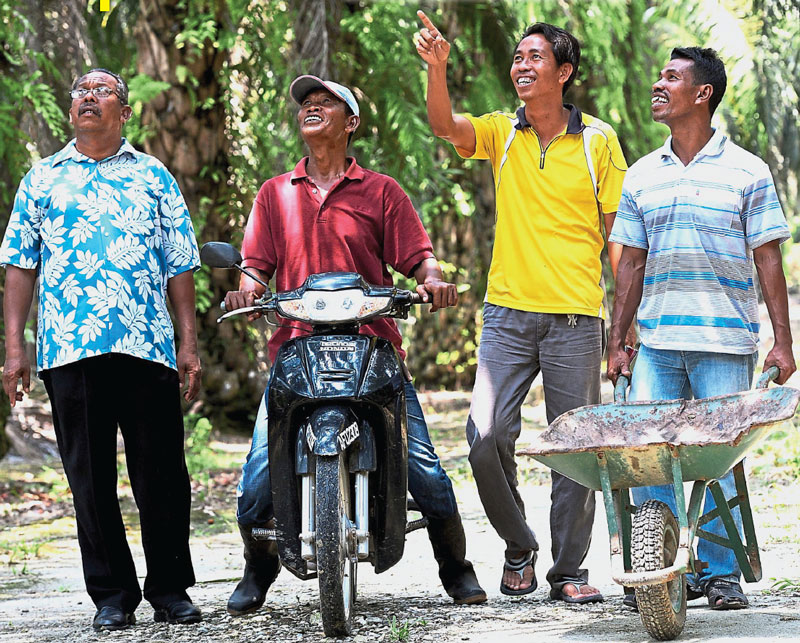 This orang asli community in Kampung Chenderong Kelubi, Perak, are among the oil palm smallholders in the country who are reaping the fruits of their labour. Smallholders make up 40% of palm oil producers in Malaysia, which is now the world’s second largest producer of the vegetable oil.
This orang asli community in Kampung Chenderong Kelubi, Perak, are among the oil palm smallholders in the country who are reaping the fruits of their labour. Smallholders make up 40% of palm oil producers in Malaysia, which is now the world’s second largest producer of the vegetable oil.
Success attracts brickbats
Palm oil as an affordable vegetable oil is targeted by NGOs with an agenda.
YOU don’t get to be 100 years old and not have problems along the way. What are the biggest challenges facing the palm oil industry at the moment? Bek-Nielsen:
Bek-Nielsen: The world is changing faster than ever, and in tune with a higher level of development we see demands changing. If we look at the last 15 years, there has been a growing change in the mindset of consumers in general, particularly in the West where demands relating to the well-being of the environment has increased. In the old days, whether it was in the United States, Brazil or parts of Europe, they just looked at forests as something to be converted. But now, when developing countries are starting to do this, it clashes with these changing demands from the consumer base who now insists on stricter standards. So we have two choices: We can either listen, or we can refuse to listen. However, if we refuse to adapt to the changing circumstances and continue with “business as usual”, then we will inevitably close the door on opportunities. It is therefore time for us to take heed of these changes and see how we can still proceed with development, but do this responsibly, thus limiting the impact on the environment. If we do that, then we will be in a position to fulfil what Winston Churchill once said, namely “difficulties mastered are opportunities won.”
Yusof: From my perspective, the palm oil industry is already very successful. The challenges that we are facing reflects our success. If you look at the statistics, we are the highest- growth commodity oil, as compared with the other oils that have been seeing a shrinking market share. To counter our success, they resort to anti-palm oil campaigns. They come up with emotional “scientific studies” to back their anti-palm oil policy agenda that is pushed to lawmakers. They have designed this as a method to overcome their lack of competitiveness in their own commodities and to protect their own farmers. European countries are
They come up with emotional “scientific studies” to back their anti-palm oil policy agenda that is pushed to lawmakers. They have designed this as a method to overcome their lack of competitiveness in their own commodities and to protect their own farmers. European countries are perpetrating the perception that palm oil is linked to deforestation and is destroying the habitat of the orang utan – which is not true. These allegations are not backed by statistics or facts. They are pandering to the NGOs’ “no deforestation” agenda to stop expansion in oil palm cultivation.
It is no longer just an NGO issue today, for these campaigns are now becoming potential legislation. Any developing country would need to clear land to develop its resources. For Malaysia, this may not be necessary but what about other developing countries? They have a lot of forests, all non-productive, but they cannot develop these forests to plant oil palm as the NGOs are also demanding that High Carbon Stock (HCS) be included as a trade standard to qualify for market access. Resolutions have been tabled at the European Parliament to ban entry of palm oil from HCS value land . All these standards are merely tools through which the European environmentalists and protectionist movements are trying to control the capability of developing countries to further develop and compete in their market. So where do we go from here? If they adopt a no-deforestation policy, the future of the palm oil industry is restricted only to the current planted area.
Lee Yeow Chor: The Malaysian Palm Oil Council (MPOC) was set up by the Government to promote palm oil, but now its responsibilities have expanded to include fighting antipalm oil sentiments and campaigns. Yes, the campaigns have elevated from just NGOs aiming to influence consumers, to now influencing the legislators as well as food companies. There are a few fronts that we can go on to address this issue. Firstly, we must form alliances. We are no longer alone in this – we have fellow producers throughout the globe. Apart from Indonesia, we have other palm oil producing countries in Africa, South America and Thailand. We have to form alliances, especially among developing countries, to speak out against this unfair treatment which is hampering our development goals. The problem is that the developed countries started converting their forests much earlier, and now that they have cleared most of their forests they are saying that we are causing the problem and impacting the environment. Secondly, to be successful palm oil players today, we don’t just need to be good planters; we must also be good communicators. We have to be very vigilant and savvy in using communication tools to rebut the unfair allegations. Of course, we must be savvy in the use of digital media, and not just the traditional media. MPOC recognises this and has been putting a lot of effort in improving communication on this front.
There are a few fronts that we can go on to address this issue. Firstly, we must form alliances. We are no longer alone in this – we have fellow producers throughout the globe. Apart from Indonesia, we have other palm oil producing countries in Africa, South America and Thailand. We have to form alliances, especially among developing countries, to speak out against this unfair treatment which is hampering our development goals. The problem is that the developed countries started converting their forests much earlier, and now that they have cleared most of their forests they are saying that we are causing the problem and impacting the environment. Secondly, to be successful palm oil players today, we don’t just need to be good planters; we must also be good communicators. We have to be very vigilant and savvy in using communication tools to rebut the unfair allegations. Of course, we must be savvy in the use of digital media, and not just the traditional media. MPOC recognises this and has been putting a lot of effort in improving communication on this front.
Secondly, to be successful palm oil players today, we don’t just need to be good planters; we must also be good communicators. We have to be very vigilant and savvy in using communication tools to rebut the unfair allegations. Of course, we must be savvy in the use of digital media, and not just the traditional media. MPOC recognises this and has been putting a lot of effort in improving communication on this front.
Lee Oi Hian: We have to focus on the competitiveness of the industry. The industry has been slacking a little bit. Yes, we are doing relatively well but we haven’t improved as much as the other competing genetically-modified crops. Productivity is key, in terms of yields as well as labour. In this sense, we are on a journey but there’s a long way to go. We have been cruising, without sufficient innovative attempts to really reap the potential yields that our scientists tell us that our planting materials are capable of doing. I believe that it is our attitude and lack of urgency that is hindering us from achieving much more. Also, one of the biggest challenges facing the industry at the moment is the critical shortage of foreign workers.
Zakaria: When I took up my position in FGV on April 1 this year, the major challenge that I saw for the company was the old trees. Many of our trees are over 20 years old and are no longer productive. The company and the settlers are facing the same problem. For the company, we can conduct replanting on 15,000 to 16,000 hectares per year, and this costs us over RM300mil. However, for the settlers they are facing a problem because replanting requires a lot of money – it will cost them at least RM15,000 per acre. So that is the challenge for them. Another big challenge I faced when I took over this role was when I wanted to improve the yields of the plantations. There was a lack of experts in this area. I found that there was a shortage of people who are really good at this, so I had to bring in the retired experts to help me. I suppose this is because many young people do not find the plantation industry attractive anymore. Probably in terms of the location and salary, and the fact that you do not have the same facilities you can find in a town area. These are some of the challenges I faced.
One of the biggest challenges facing the industry at the moment is the critical shortage of foreign workers. Can this problem be resolved in the near futureWong:
Wong: From the Sarawak perspective, the shortage of workers at the operational level has become the greatest challenge for the industry today. Sarawak only produces an average 16 tonnes of fresh fruit bunch per hectare, while more established companies like United Plantations have an average yield of almost 26 tonnes per hectare. For Sarawak to fully realise its yield potential, it is important that the shortage of workers be addressed urgently. I also noticed that the local smallholders are also facing the same shortage of workers.
Bek-Nielsen: No responsible country will accept a massive influx of guest (foreign) workers and the Malaysian government, no doubt, wants to act responsibly in this issue. It is a balancing act. Our industry has a relatively small percentage of guest workers when compared to the total number of guest workers seeking employment in Malaysia. I don’t think it is even 15% of the total number of them legally employed in Malaysia. However, the palm oil industry contributes 8% to the country’s GDP and therefore it punches well above its weight. In addition, the earnings on plantations are good and the companies provide them with free housing, free water, medical and electricity. Which other industry in Malaysia does that? Malaysia is developing very fast. Urbanisation is like a huge magnet, pulling a sea of people into the bigger towns. While this is happening now in Malaysia, the same movement has taken place in Western Europe and the US decades ago where a large proportion of agriculture in these developed countries, especially fruit orchards and vegetable production entities, are heavily dependent on Eastern European or Latino workers. Without these hard-working individuals, their agricultural production would collapse, similar to what the palm oil industry would be exposed to if we could not legally recruit guest workers from Bangladesh, Indonesia and other parts of the world. This is the reality and we need to appreciate these facts. It is not that our industry doesn’t want to innovate or move forward. We all want to try to minimise our dependency on workers, but this takes time and is easier said than done. Indeed, we need to be more aggressive in our pursuit to minimise our dependency on labour but to think we can come to levels comparable to temperate crops is just not realistic. However, we must aspire and make concerted efforts to raise the present productivity through increasing the level of mechanisation and innovation. Targets should be set and with that I am sure that we will live up to the saying that “necessity is the mother of all inventions”.
Lee Oi Hian: Regarding social problems associated with workers, this is minimal in our industry as we are rural-based and the majority of workers are provided with housing in estates with medical services and other facilities. They go to town only once in a while. Twenty years ago, to get a passport it was an arduous process that took such a long time. Look at it now, it is so well done. The authorities can develop a similarly efficient process of bringing foreign workers into the plantation industry. The current process is so long. For our industry, when you cannot bring in workers on time, you cannot pass the baton – it is like relay. When we don’t have workers, you lose the crop. Every tonne of crop that we lose, the Government also loses an equal significant part of their share. The Government has to develop a system for the plantation industry alone, where they can monitor the number and whereabouts of the worker that we bring in. They need to ensure that we don’t have illegals working in our plantations. There may be some illegal workers among the contractors and smallholders but if we do not improve the system, it will not be resolved.
Bek-Nielsen: I agree, and we would like to appeal for a simplified process without undermining the legality, so that we can expedite the movement in the recruitment and also repatriation of workers. We must remember that what this industry produces is unlike a concrete block or rubber tyre. This is a perishable fruit and you have a certain expiry date on it. If you fail to bring it down, it is going to rot.
Eye on the competition
How Malaysia can up its game in the palm oil market.
IN recent years, Malaysia seems to be losing its market share particularly to Indonesia in major traditional export markets. Is this an indication that Malaysia is losing its competitive edge? How do we address this issue? Lee Yeow Chor: Indonesia is the world’s largest producer. They produce 33 million tonnes and we produce about 20 million tonnes.
When we talk about competitiveness, there are many aspects to it. In terms of cost competitiveness, we always say that the Indonesians undercut us. That may be so but I don’t think we should only look at one aspect of competitiveness. Some quarters suggest that the export duty in Indonesia is making us less competitive but to me this export duty imposed in Indonesia is a zero sum game. The export duty is at the expense of CPO producers in Indonesia who now have to deflate their CPO prices so that the refiners will get cheaper raw material.
But when you have market distorting measures like this, inefficiencies are likely to happen. Within a very short period of time, there was a boom in the construction of new refineries in Indonesia. We are now seeing an overcapacity of refineries there. Back to competitiveness, cost competitiveness is of course important especially within our traditional markets like China, and even in the United States where the Indonesians have gained a much greater market share than Malaysians, and I think we have to accept that.
So what can we do? We should open up new markets. In this respect, I believe there are still corners in the world where there are many opportunities for vegetable oils like palm oil to grow their markets. One of the areas that MPOC is very hopeful about is Africa. In West Africa and East Africa, the rate of growth has been great and we think it is going to continue at this pace.
Another aspect we should look at, instead of just market share, is how to value-add for every tonne of palm oil that we produce. We need to add value and add margins to the palm oil that we produce. We should go into more lucrative segments for food, nutraceuticals and so on. We must adopt a new benchmark in which we strive to maximise the margin for every tonne of
Malaysian palm oil produced. That should be our goal in this environment that we are in.
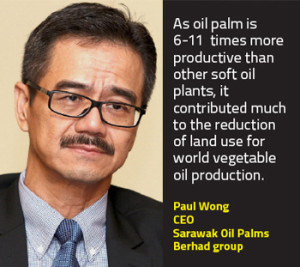 Wong: We are trading about 1.2 million tonnes out of Sarawak and we sell to markets like China, India, Africa, Vietnam, the Philippines and others. We do find that the Indonesian producers are far ahead of us in certain price-sensitive markets.
Wong: We are trading about 1.2 million tonnes out of Sarawak and we sell to markets like China, India, Africa, Vietnam, the Philippines and others. We do find that the Indonesian producers are far ahead of us in certain price-sensitive markets.
For example, for the Pakistan market which is very price-sensitive, the Indonesian producers are willing to sell cheaper than us. But are we willing to go in and compete with them? If yes, we can get the share of the market. It is not because Malaysians are less competitive that we are losing the market share. It’s just that the market is competitive and changing all the time. For Malaysia, we are always exploring and expanding into new markets.
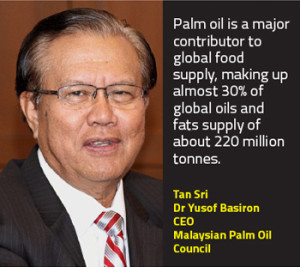 Yusof: This competition between Malaysia and Indonesia reflects the volume available from the two countries. We are probably 36% of production share, and they are nearing 60% in terms of volume available. The market will reflect that, even if we want to hold on to our past share of the market in China or Pakistan.
Yusof: This competition between Malaysia and Indonesia reflects the volume available from the two countries. We are probably 36% of production share, and they are nearing 60% in terms of volume available. The market will reflect that, even if we want to hold on to our past share of the market in China or Pakistan.
Firstly, there are some competitive advantages for the Indonesians due to the distortion of the tax system in the country. Secondly, producers take loans from banks to develop their plantations. Like any other business, they have to remain profitable to ensure they can service their loans.
They have big bank borrowings and young plantations, so this is a case of cash flow opportunity for them – even selling at a discount.
This is only a transition phase. In the future, the huge over-capacity in their refinery will create strong demand for their CPO,thus returning their competitiveness to be at par with Malaysian exporters.
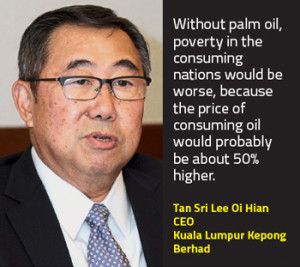 Lee Oi Hian: We have to be sensitive to our customers’ needs too. We need to think about them also wanting to encourage their refining industries and downstream.
Lee Oi Hian: We have to be sensitive to our customers’ needs too. We need to think about them also wanting to encourage their refining industries and downstream.
In the context of total investments, our plantations make up the major percentage with refining a tiny fraction. Could we be more liberal in our duty structure to encourage more purchase of crude palm oil against soya oil and canola oil by our key customers? Then we don’t need to subsidise so much biodiesel. This is a balance that
Malaysia and Indonesia need to think about.
It is a better policy to let our major customers in India, Bangladesh, Pakistan, etc, develop their own refining industries to encourage them to consume more palm oil. Competition may force our own refineries to go more downstream into more value- added products.
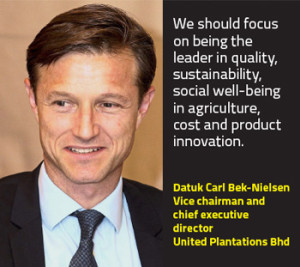 Bek-Nielsen: Indonesia is going to proceed and grow at a more rapid rate for obvious reasons. It has a huge land mass compared to us and a huge population. Indonesia is also already a huge consumer of palm oil.
Bek-Nielsen: Indonesia is going to proceed and grow at a more rapid rate for obvious reasons. It has a huge land mass compared to us and a huge population. Indonesia is also already a huge consumer of palm oil.
For Malaysia to go forward and to protect ourselves in terms of market share we need to up the mark. We have to see how we can move up the value ladder.
In my view we should try to be the “Switzerland” in the palm oil sector by focusing on five things.
Firstly we should focus on quality. We should be the leader in quality, and the leader in sustainability. Secondly we should also be the leader in social well-being in agriculture, and of course, we have to be the cost leader and get the highest yields at the lowest cost of production.
Finally, we have to be the leaders in product innovation and that is where we really have to move.
If we can fulfill all these, then I am sure that our future will be bright as there will always be people who want to pay for quality, for sustainability, and for products which are virtuous.
The year in review … and what lies ahead
HOW would you relate your experience this year from the impact of the super El-Nino episode on your plantations? And what are your expectations for the year ahead?
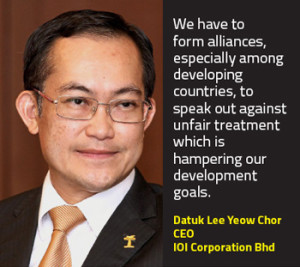 Lee Yeow Chor: I had never imagined prior to this that the weather could play such an important role. We always believed in good planting material and good agronomic practices. These are important, but weather – especially drought – can change all that.
Lee Yeow Chor: I had never imagined prior to this that the weather could play such an important role. We always believed in good planting material and good agronomic practices. These are important, but weather – especially drought – can change all that.
This year, we were hit with the effects of drought, not just from last year but also early this year. At the same time, there was a double whammy in that the Government also announced the freeze in foreign labour intake in February, and that created a lot of havoc and uncertainty in the recruitment process.
At today’s palm oil stock level of 1.5 million tonnes and two months ago at 1.4 million tonnes, prices should have moved much higher because it is a very low-stock level.
However, prices have been sort of capped, due to two main factors. One is the price of petroleum which dictates the usage of vegetable oil for biodiesel, not just palm oil but vegetable oil in general. Secondly, of course, the still abundant supply of soybean oil in the market.
These factors have played a major role in capping how high palm oil prices can go. Nevertheless, prices have moved up. I believe there is a positive support at this current price level and moving forward, prices will be positive.
Bek-Nielsen: The weather will always make the crop. We had severe El Nino last year and the repercussions of that have been extreme. I am convinced that Malaysia during 2016 will achieve its lowest yields per hectare in the past 25 years.
It has indeed been a challenging year but nevertheless, a year that has been blessed with better prices. I expect production next year will recover with prices very likely heading lower.
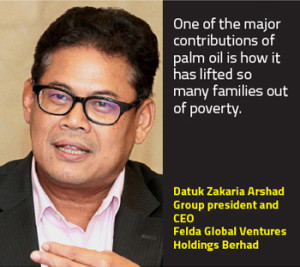 Zakaria: I think 2016 is a very challenging year for the Malaysian palm oil industry. We were badly affected by El Nino, and we continue to be affected until now. I expect next year to be better for the palm oil industry in terms of yield.
Zakaria: I think 2016 is a very challenging year for the Malaysian palm oil industry. We were badly affected by El Nino, and we continue to be affected until now. I expect next year to be better for the palm oil industry in terms of yield.
Lee Oi Hian: After El Nino, I think we are going to have a much higher crop in the second half of 2017 and in 2018. I am happy to see our Plantation Industries and Commodities Ministry’s flexible policy on the deferring of the biodiesel policy for the industrial sector. It is a good move.
You should save your money for when you really need to subsidise. The price of palm oil is adequate now, why spend reserves subsidies? This is the first time I have seen the ministry adopting a flexible policy, and I would like to pass our word of encouragement to them on this.
Wong: For the next six months, I believe that our production is going to be low and it will not recover so fast. It will only recover in the second half of 2017 onwards, even though we see a slight recovery at the moment due to the seasonal crop pattern. In Sarawak, due to the severe El Nino impact, the most affected area is the northern region while the central and the southern regions of Sarawak are less affected.
Yusof: There was severe underestimation in the market about the production of palm oil in Malaysia and Indonesia for this year and next year. The El Nino occurred for 11/2 to two years. That put a huge strain on our palm oil industry and it will take about two years to recover.
Yes, the fact that production is low, prices should be high and that would comfort producers. It is a balancing act in the market place.
But keep in mind that soybean has been doing exceptionally well for the last five years. Production has somehow been very good. Nevertheless, North and South America cannot have perfect weather continuously for five or 10 years. And when the weather pattern changes, their supplies will be affected, and the beneficiary will be palm oil.
Our production is recovering and likely to increase. Should there be drought or floods in the near future, the supply of soybean oil will be reduced and palm oil prices will increase.





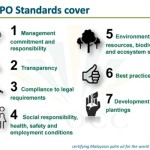

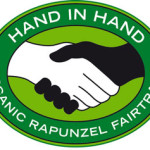


Leave a Reply